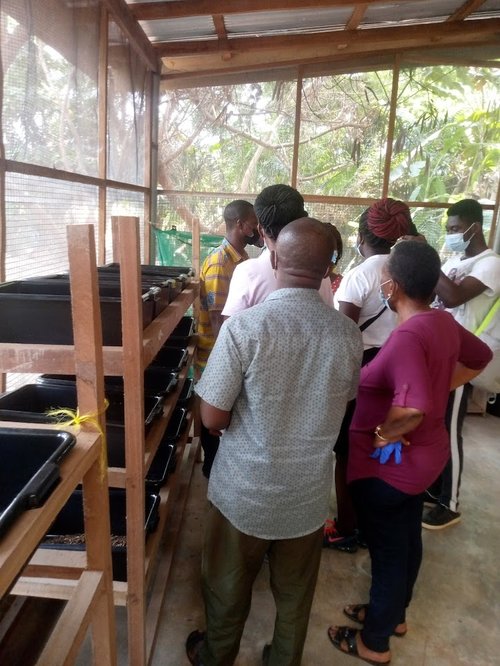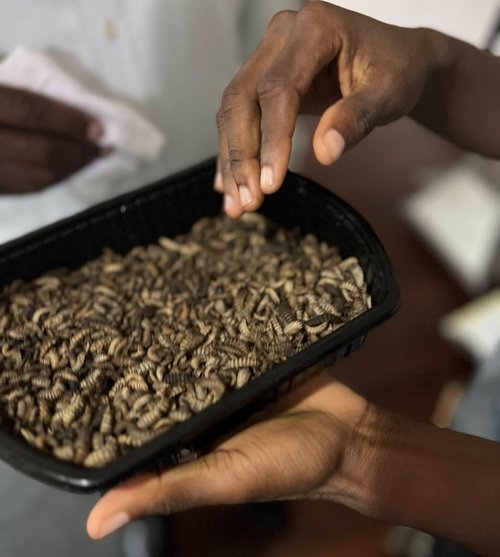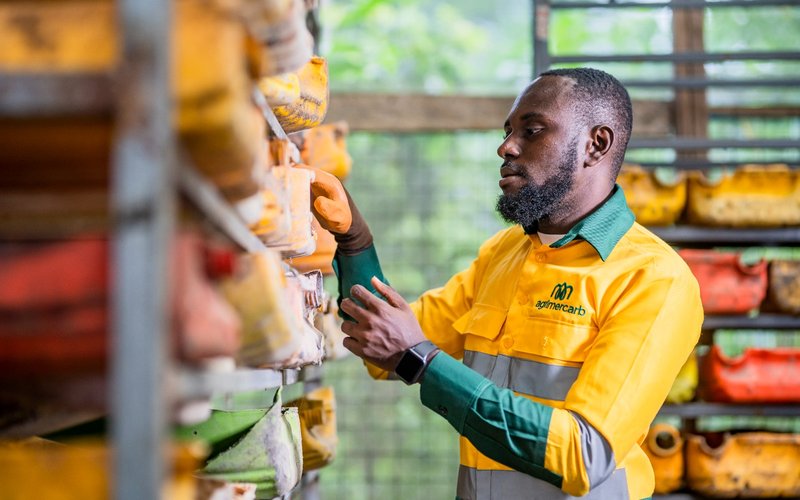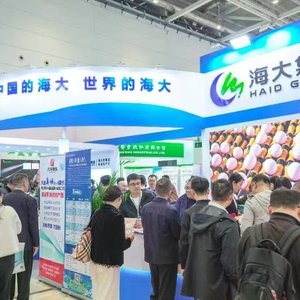All over Africa, black soldier fly (BSF) have shown great potential for providing the aquaculture industry with a badly needed boost. Aquaculture is being prioritized because, with the sharp declining capture fish output over the years, it is the best means of producing significant quantities of fish to cut Africa’s high fish import bills, and produce protein for a fast-expanding population, with overflow for the other industries.
BSF has been found to be a viable alternative to soybean meal, the expensive main protein source for fish feeds, which is part of the reason why African fish farmers spend over 70% of their budgets on feed. In addition to being a preferred cheap ingredient in tilapia and catfish diets, BSF is also useful for biodegrading municipal waste, during which process it also produces a valuable compost capable of saving substantial amounts spent on fertilizer imports. But despite many interventions supported by international agencies, Africa is only beginning to show signs of increasing BSF production to the point where it will make a real difference. There are signs that the African mealworm, with its peculiar capacity to degrade plastic, will soon join BSF to scale up production to generate economies for aquaculture and other sectors.
There are quite several major BSF projects all over the continent, most of them involving training programs that are providing livelihoods for rural BSF producers. In West Africa, the three-year BSF Bio-Circular Economy and Environmental Sustainability (BBEST) project, aimed at improving aquaculture, pig and fish production, urban sanitation and compost production in Ghana, Mali and Niger, was launched in 2022. Sponsored by the Norwegian Agency for Development, the program is managed by the Nigeria-based International Institute for Tropical Agriculture (IITA). At the 3rd Annual Review held in Accra on February 25, 2025, participants expressed satisfaction with the number of people from various communities who acquired income-earning skills, which have enabled them to contribute to the economy.
In the Ivory Coast, the FAO-sponsored project Circular bioeconomy in Abidjan: from Food Waste to the Fork (BioDAF) is deploying BSF larvae to provide a valuable protein source for the fast-expanding aquaculture industry and deal with the massive 2,500 tons of municipal waste generated daily.
In Kenya, Farm Africa partnered with the Mastercard Foundation to promote BSF production among young people taking part in Youth in Sustainable Aquaculture (YISA) program. The project, started in 2023, aimed at creating 150,000 jobs for young people in the production of BSF larvae for the production of fish feed.
Small scale

But while there is a general appreciation of the usefulness of BSF projects in Africa, some experts believe that they are mostly basic interventions at the micro or subsistence sector, which cannot make a substantial impact on large-scale production in aquaculture and the other areas where their potential has been demonstrated.
Mr. Kwabena Tufuor, CEO of Eco Protin, a Ghanaian BSF producer, says that “the efforts being made to promote BSF training are commendable. Beneficiaries of the training are earning some decent income through selling their produce to small fish and poultry farmers. However, production needs to be scaled up to the appropriate industrial levels with suitable technology in order to make the expected impact, especially on aquaculture. BSF production is a technical engagement requiring skill and investment in equipment and logistics. In addition to basic equipment to ensure efficient production, you need effective arrangements for the supply of substrates, increased output and product distribution. Presently, there is not much BSF production for commercial feed producers in Africa, although the trend is changing elsewhere.”
He said that “BSF has great potential, but we need to do more R&D to make a difference. For example, BSF production in our part of the world slowed down during the January/February Harmattan season due to the reduced humidity, but as a result of the efforts of some of our colleagues in controlled environment tests, we are now producing all year round. In Africa, our climate offers us a favorable environment to produce BSF on a large scale, but we are yet to take full advantage of this.”
Enter mealworm
Interestingly, another insect with some similar characteristics to BSF is gaining prominence, with potential as a protein source for fish, as compost and, most significantly, with the capacity to consume polystyrene and help solve the huge plastic pollution problem in Africa. The mealworm, believed to have originated from Africa but now spread worldwide, has been garnering a lot of interest since it became the first insect-based food approved by the European Food Safety Agency in January 2021. Quite a number of studies recommend mealworms as feed. For example, Shahida Anusha Siddiqui et al. (2024) state that “mealworms are a great alternative to conventional livestock feed because of their identical essential amino acid content and nutritional profile to that of fish”. There are good indicators that, like those of the black soldier fly, the characteristics of two mealworm species, the larvae of the lesser mealworm (Alphitobius daperinus) and the yellow mealworm (Tenebrio molitor LA) will substantially impact the sustainability and profitability of aquaculture. In addition, they will be valuable as generators of compost and in the management of municipal waste. Recent interest in commercial mealworm production indicates good prospects for the entire industry.
Scaling up
Mr. Luther Quarshie, CEO of AgriMercarb, a Ghanaian producer of BSF, who has been supplying BSF to fish farmers for a while, says that “players involved in BSF production need to join hands and will be a key element in order to generate the quantities of larvae needed to meet the requirements of the aquaculture sector. Imported soybean meal, the main protein source for fish feed, accounts for a substantial portion of the cost of commercial fish feed, making it too expensive for most Ghanaian and African fish farmers. Through our combined efforts, we can reduce the cost of fish feed. The recent interest in mealworm production will increase the amount of alternative protein products available to the various operators in the industry.”
Moreover, the discovery by the Kenya-based International Centre for Insect Physiology and Ecology (ICIPE) that the lesser mealworm larvae could had the ability to consume and degrade polystyrene, offers a prospect of a solution to the massive problem of plastic waste in Africa. Researchers found that larvae could consume nearly 50% of the polystyrene fed to them, and their efficiency increased when the plastic feed was mixed with bran or grain husks. While Africa imports a large amount of plastic products, very little re-use and virtually no recycling is done.
Luther Quarshie believes that “previously, mealworms were grown mainly in East Africa. But interest is growing in Ghana and Nigeria, and I believe that we will soon see increased production for fish farming and compost production all over Africa. I expect that municipal authorities will soon support the production of mealworm larvae for large-scale conversion of plastic and other wastes.”
Further value addition

Some years ago, insects were an important part of the African diet. Grasshoppers, palm weevils, black soldier flies and mealworms were regularly eaten in various forms. This tradition barely survives in rural Africa, but in some urban parts of Ghana and Kenya, it is returning with a bang. Public interest in insects as food is rising, especially in East Africa.
In Ghana, the palm weevil is making a big entry into modern food culture with smart takeaway joints, well-packaged food, and attractive sales and delivery staff, drawing increased numbers of customers. BSF snack packs are appearing on the scene. A group of entrepreneurs involved in BSF production is discussing the possibility of developing a market for chitin and chitosan. Atta Sackey, a fish farmer and member of the group, believes that by working together, local groups would be able to access the lucrative international market. “The chitin and chitosan markets are very lucrative, and we have the raw material,” he says, “but we recognize that traditional chitin and chitosan processing involves expensive equipment and advanced techniques, so we are seeking partnerships with interested people. We are also looking at affordable alternatives.”
The Ghanaian and African insect value chain appears modest presently, but could be significantly big in the near future.










